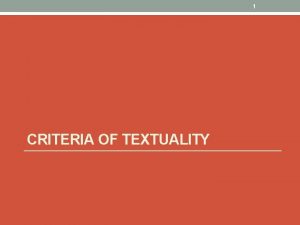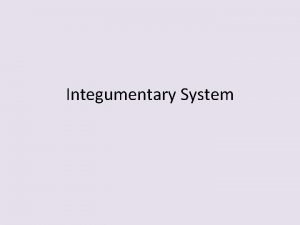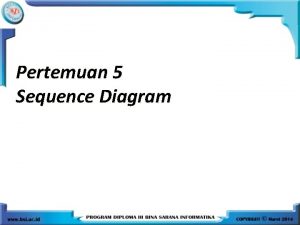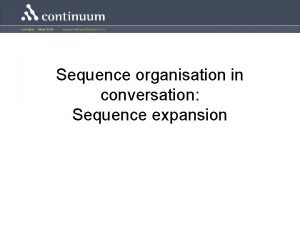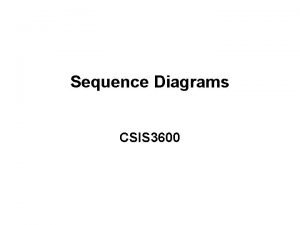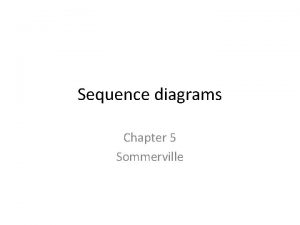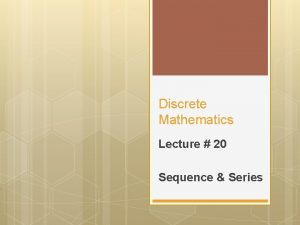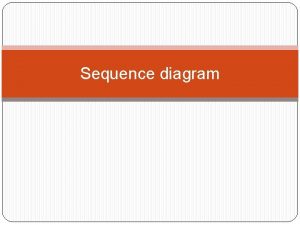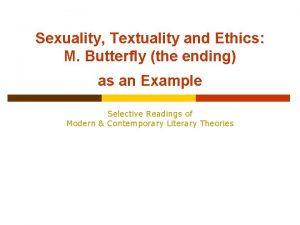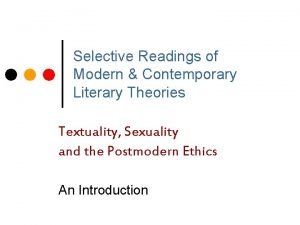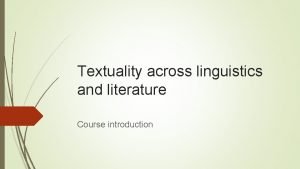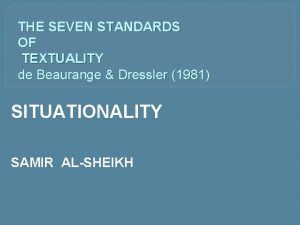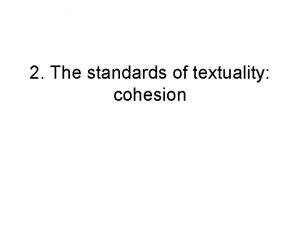1 CRITERIA OF TEXTUALITY What makes a sequence

























- Slides: 25

1 CRITERIA OF TEXTUALITY

What makes a sequence of sentences or utterances a text? Is the following fragment is a normal text? John wants to visit his girlfriend. Mr. Smith lives in a small village nearby. The vacuum cleaner didn't work. The barber down the street couldn't help. The last paper had been sold. It is going to be a long dull talk. This fragment seems to have come into existence by placing a number of unrelated sentences in random order. But if some words are changed, a text is the result.

John wants to visit his girlfriend. Mary lives in a small village nearby. The car wouldn't start. The garage down the street couldn’t help. The last bus had already left. It is going to be a long hot walk. The existence of connections between sentences is an important characteristic of texts. In the literature on this topic, seven criteria are given for textuality, that is, criteria that a sequence of sentences must meet in order to qualify as a text.

Cohesion (bağlaşıklık) is the connection which results when the interpretation of a textual element is dependent on another element in the text. Consider the following example. The store no longer sold porcelain figurines. It used to, the man behind the counter said, but they didn't sell very well. Since the business had switched to plastic, sales were doing a lot better.

Five types of cohesion 1. Substitution is the replacement of a word(group) or sentence segment by a 'dummy' word. The reader or listener can fill in the correct element based on the preceding. There are three types of substitution, that of a noun (11), of a verb (12) and of a clause (13). (11) These biscuits are stale. Get some fresh ones. (12) A: Have you called the doctor? B: I haven't done it yet, but I will do it. A: Though actually, I think you should do it. (13) A: Are they still arguing in there? B: No, it just seems so.

2. Ellipsis, the omission of a word or part of a sentence, is closely related to substitution. Ellipsis can be described as 'substitution by zero'. In the case of ellipsis, the division that is normally used is the same as that applied to substitution: nominal, verbal and clausal ellipsis. (14) These biscuits are stale. Those Ø are fresh. (15) He participated in the debate, but you didn't Ø. (16) Who wants to go shopping? You Ø?

3. Reference, the act of referring to a preceding or following element, deals with a semantic relationship. Substitution and ellipsis deal with the relationship between grammatical units: words, sentence parts and clauses. In the case of reference, the meaning of a 'dummy' word can be determined by what is imparted before or after the occurrence of the dummy word. In general, the dummy word is a pronoun. (17) I see John is here. He hasn't changed a bit. (18) She certainly has changed. No, behind John. I mean Karin.

But reference can also be achieved by other means, for instance, by the use of a definite article or an adverb as in the following examples: (19) A man crossed the street. Nobody saw what happened. Suddenly the man was lying there and calling for help. (20) We grew up in the 1960 s. We were idealistic then.

4. Conjunction is a relationship which indicates how the subsequent sentence or clause should be linked to the preceding or the following (parts of the) sentence. This is usually achieved by the use of conjunctions. The following are examples of three. frequently occurring relationships; addition, causality, temporality. The relationship can be hypotactic (as in the a-examples which combine a main clause with a subordinate clause or phrase) or parataetic (as in the b-examples which have two main clauses).

addition (21 a) Besides being mean, he is also hateful. (21 b) He no longer goes to school and is planning to look for a job. causality (22 a) He is not going to school today because he is sick. (22 b) Mary got married to John last year and now she's pregnant. temporality (23 a) After the car had been repaired, we were able to continue our journey. (23 b) The car was repaired. Afterwards we were able to continue our journey.

5. Lexical cohesion does not deal with grammatical and semantic connections but with connections based on the words used. Two types of lexical cohesion can be distinguished: reiteration and collocation. Reiteration includes not only repetition but also synonymy. Reiteration can also occur through the use of a word that is systematically linked to a previous one, for example, "young" and "old". In general, reiteration is divided into the following five types.

a. repetition (often involving reference) (24) A conference will be held on national environmental policy. At this conference the issue of salination will play an important role. b. synonymy (often involving reference) (25) A conference will be held on national environmental policy. This environmental symposium will be primarily a conference dealing with water. c. hyponymy (e. g. , the relation of "flower" to "tulip") (26) We were in town today shopping for furniture. We saw a lovely table. d. meronymy (part vs. whole) (27) At its six-month checkup, the brakes had to be repaired. In general, however, the car was in good condition. e. antonymy (e. g. , "white" vs. "black") (28) The old movies just don't do it any more. The new ones are more appealing.

Collocation, the second type of lexical cohesion, deals with the relationship between words on the basis of the fact that these often occur in the same surroundings. Some examples are: "sheep" and "wool", "congress" and "politician" or "college" and "study". (29) Red Cross helicopters were in the air continuously. The blood bank will soon be desperately in need of donors. (30) The hedgehog scurried across the road. Its speed surprised me.

Coherence (tutarlılık) is the connection which is brought about by something outside the text. This 'something' is usually knowledge which a listener or reader is assumed to possess. The following example is not problematic in terms of cohesion even though the sentences hardly seem to be connected.

The procedure is actually quite simple. First you arrange things into different groups. Of course, . one pile may be sufficient depending on how much there is to do. If you have to go somewhere else due to lack of facilities, that is the next step, otherwise you are pretty well set. It is important not to overdo things. That is, it is better to do too few things at once than too many. In the short run this may not seem important, but complications can easily arise. A mistake can be expensive as well. At first the whole procedure will seem complicated. Soon, however, it will become just another facet of life. It is difficult to foresee any end to the necessity for this task in the immediate future, but then one never can tell. After the procedure is completed, one arranges the materials into different groups again. Then they can be put into their appropriate places. Eventually they will be used once more and the whole cycle will then have to be repeated. However, that is part of life.

This seemingly disjointed passage becomes coherent when certain knowledge of the world, i. e. , knowledge of washing clothes, is applied to the text. The text then becomes easy to interpret. • Tutarlılık metnin önermelerinin birbiriyle mantıksal anlamsal olarak bir bu tu nlu k oluşturmasıdır. Bölgesel tutarlılık metinde birbirini izleyen tu mceler arasında; bu tu ncu l tutarlılık ise metnin örneğin paragraflar gibi konu ve alt konular› belirleyen tu mceden daha bu yu k parçaları arasında oluşur.

Intentionality (amaçlılık)means that writers and speakers must have the conscious intention of achieving specific goals with their message, for instance, conveying information or arguing an opinion. The following conversation is between a mother and her son: Mother: Yerdeki palto senin mi? Son: Evet. Here, the discourse participants are the mother and the son. It shows the exploitation of intentionality of the mother’s question: The intention can be a request to pick up the coat from the floor or an information question to find out the answer. In the case of the request, the son intentionally or unintentionally fails to understand this request; rather he deals with this as a simple content question which can be answered as yes /no.

Acceptability (kabuledilebilirlik) requires that a sequence of sentences be acceptable to the intended audience in order to qualify as a text. Bir düğu n töreninde, yeni evlileri kutlamak için söylenen şu sözler kabuledilebilirlik taşımıyacaktır: “ On yıllık evliliğinizin bu ilk gu nu nde, size başsağılığı dilerim. ” Bu sözler şu nedenlerle kabuledilebilirlik taşımamaktadır: • Bağlaşık ve tutarlı değildir. • Durum bağlamına uygun değildir. Tu mceler iletişimsel amaçlarını yerine getirmemektedir. • Kabuledilebilirlik, metnin bağlaşık ve tutarlı olmasının yanı sıra kullanılıdığı bağlamın gerektirdiği özellikleri de taşımasıdır

Informativeness (bilgisellik) is necessary in discourse. A text must contain new information. If a reader knows everything contained in a text, then it does not qualify. Likewise, if a reader does not understand what is in a text, it also does not qualify as a text. a)Beni annem doğurdu. Bir başka deyişle beni babam doğurmadı. Yani benim bir annem var. b) Su sudur. Yani, suyu su yapan su olmasıdır. • Bilgisellik, metnin alıcısı için yeni bilgi içermesi koşuluna işaret eder.

Situationality (durumsallık) is essential to textuality. So, it is important to consider the situation in which the text has been produced and dealt with. OKUL ALANI HIZI AZALT Yol ilişkin bu uyarılar yalnızca su ru cu ler için belli bir anlam taşır. Yayalar bu işaretin aktardğı bilgiyi dikkate almaz • Durumsallık, metnin kullanıldığı belli bir durumda, o duruma özgü iletşimimsel amaçlara hizmet etmesidir.

Intertextuality (metinlerarası ilişki) means that a sequence of sentences is related by form or meaning to other sequences of sentences. This chapter is a text because it is related to the other chapters of this book. And this book is a text because it is a member of the group of scholarly introductions. Bir bilimsel yazıdaki alıntılar, bir gazete köşe yazısındaki göndermeler ya da bir karşılıklı konuşmada geçen önceki sözlere yönelik hatırlatmalar metinlerarası ilişkinkinin örnekleridir. • Metinlerarası ilişki, her metnin önceki diğer metinlerle kurduğu bağlarla ilişkilidir.

‘Intertextuality' is only dealt with in the field of text typology. 'Situationality' and the subjective characteristics 'intentionality' and 'informativeness' are of only secondary importance. They do play a role in research into textual functions where function is defined as the goal (intentionality) and the effect (primarily the transfer of information) in a specific situation. The criterion 'acceptability' only occurs in normative approaches to discourse studies, for example, in the investigation into the question: what is a good text? The concept of coherence plays a role primarily in research on text processing: which knowledge (outside the text) is used to make connections within a text? In discourse studies much attention has been paid to the first criterion for textuality: 'cohesion', the apparent connections in discourse.

Metinsellik Metin Merkezli Ölüçtler Kullanıcı Merkezli Ölçütler • Bağlaşıklık • Amaçılılık • Tutarlılık • Durumsallık • Kabuledilebilirilik • Bilgisellik • Metinlerarası ilişki

7 criteria of textuality Text as a communicative event that must satisfy the following seven criteria: 1) Cohesion, which has to do with the relationship between text and syntax. Phenomena such as conjunction, ellipsis, anaphora, cataphora etc. are basic for cohesion. 2) Coherence, which has to do with the meaning of the text. Here we may refer to elements of knowledge or to cognitive structures that do not have a linguistic realization but are implied by the language used, and thus influence the reception of the message by the interlocutor. 3) Intentionality, which relates to the attitude and purpose of the speaker or writer.

4) Acceptability, which concerns the preparation of the hearer or reader to assess the relevance or usefulness of a given text. 5) Informativity, which refers to the quantity and quality of new or expected information. 6) Situationality, which points to the fact that the situation in which the text is produced plays a crucial role in the production and reception of the message. 7) Intertextuality, which refers to two main facts: a) a text is always related to some preceding or simultaneous discourse; b) texts are always linked and grouped in particular text varieties or genres (e. g. : narrative, argumentative, descriptive, etc. ) by formal criteria.
 Criteria of textuality
Criteria of textuality Standards of textuality
Standards of textuality Difference between infinite and finite sequence
Difference between infinite and finite sequence Convolutional sequence to sequence learning
Convolutional sequence to sequence learning Nucleotides of rna
Nucleotides of rna Selection in pseudocode
Selection in pseudocode Explicit costs are payments the firm makes for
Explicit costs are payments the firm makes for Iztools
Iztools How to describe good work ethic
How to describe good work ethic Cinderella story elements
Cinderella story elements What makes one biome different from another?
What makes one biome different from another? How does hair curl
How does hair curl Limerick poem rhyme scheme
Limerick poem rhyme scheme Image trace makes white box
Image trace makes white box Meiosis makes gametes
Meiosis makes gametes Pen name of the author of the doll's house
Pen name of the author of the doll's house Angiosperm with one seed leaf
Angiosperm with one seed leaf Atomic number mass
Atomic number mass What makes a good employee
What makes a good employee Granny torrelli makes soup summary
Granny torrelli makes soup summary What makes up each of jupiter's three distinct layers
What makes up each of jupiter's three distinct layers Five cs of pricing
Five cs of pricing What makes landscapes distinctive
What makes landscapes distinctive What makes someone a leader
What makes someone a leader What makes you laugh passive voice
What makes you laugh passive voice What makes a character believable
What makes a character believable
